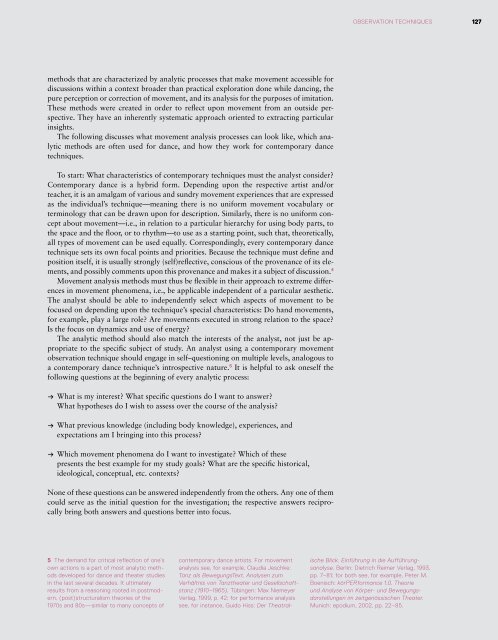Dance Techniques 2010
What does today's contemporary dance training look like? Seven research teams at well known European dance universities have tackled this question by working with and querying some of contemporary dance s most important teachers: Alan Danielson, Humphrey/Limón Tradition, Anouk van Dijk, Countertechnique, Barbara Passow, Jooss Leeder Technique, Daniel Roberts Cunningham Technique, Gill Clarke Minding Motion, Jennifer Muller Muller Technique, Lance Gries Release and Alignment Oriented Techniques. This comprehensive study includes interviews, scholarly contributions, and supplementary essays, as well as video recordings and lesson plans. It provides a comparative look into historical contexts, movement characteristics, concepts, and teaching methods. A workbook with two training DVDs for anyone involved in dance practice and theory. Ingo Diehl, Friederike Lampert (Eds.), Dance Techniques 2010 – Tanzplan Germany. With two DVDs. Berlin: Henschel 2011. ISBN 978-3-89487-689-0 (Englisch) Out of print.
What does today's contemporary dance training look like? Seven research teams at well known European dance universities have tackled this question by working with and querying some of contemporary dance s most important teachers: Alan Danielson, Humphrey/Limón Tradition, Anouk van Dijk, Countertechnique, Barbara Passow, Jooss Leeder Technique, Daniel Roberts Cunningham Technique, Gill Clarke Minding Motion, Jennifer Muller Muller Technique, Lance Gries Release and Alignment Oriented Techniques.
This comprehensive study includes interviews, scholarly contributions, and supplementary essays, as well as video recordings and lesson plans. It provides a comparative look into historical contexts, movement characteristics, concepts, and teaching methods. A workbook with two training DVDs for anyone involved in dance practice and theory.
Ingo Diehl, Friederike Lampert (Eds.), Dance Techniques 2010 – Tanzplan Germany. With two DVDs. Berlin: Henschel 2011. ISBN 978-3-89487-689-0 (Englisch) Out of print.
Create successful ePaper yourself
Turn your PDF publications into a flip-book with our unique Google optimized e-Paper software.
Observation <strong>Techniques</strong> 127<br />
methods that are characterized by analytic processes that make movement accessible for<br />
discussions within a context broader than practical exploration done while dancing, the<br />
pure perception or correction of movement, and its analysis for the purposes of imitation.<br />
These methods were created in order to reflect upon movement from an outside perspective.<br />
They have an inherently systematic approach oriented to extracting particular<br />
insights.<br />
The following discusses what movement analysis processes can look like, which analytic<br />
methods are often used for dance, and how they work for contemporary dance<br />
techniques.<br />
To start: What characteristics of contemporary techniques must the analyst consider?<br />
Contemporary dance is a hybrid form. Depending upon the respective artist and / or<br />
teacher, it is an amalgam of various and sundry movement experiences that are expressed<br />
as the individual’s technique—meaning there is no uniform movement vocabulary or<br />
terminology that can be drawn upon for description. Similarly, there is no uniform concept<br />
about movement—i.e., in relation to a particular hierarchy for using body parts, to<br />
the space and the floor, or to rhythm—to use as a starting point, such that, theoretically,<br />
all types of movement can be used equally. Correspondingly, every contemporary dance<br />
technique sets its own focal points and priorities. Because the technique must define and<br />
position itself, it is usually strongly (self)reflective, conscious of the provenance of its elements,<br />
and possibly comments upon this provenance and makes it a subject of discussion. 4<br />
Movement analysis methods must thus be flexible in their approach to extreme differences<br />
in movement phenomena, i.e., be applicable independent of a particular aesthetic.<br />
The analyst should be able to independently select which aspects of movement to be<br />
focused on depending upon the technique’s special characteristics: Do hand movements,<br />
for example, play a large role? Are movements executed in strong relation to the space?<br />
Is the focus on dynamics and use of energy?<br />
The analytic method should also match the interests of the analyst, not just be appropriate<br />
to the specific subject of study. An analyst using a contemporary movement<br />
observation technique should engage in self–questioning on multiple levels, analogous to<br />
a contemporary dance technique’s introspective nature. 5 It is helpful to ask oneself the<br />
following questions at the beginning of every analytic process:<br />
→ What is my interest? What specific questions do I want to answer?<br />
What hypotheses do I wish to assess over the course of the analysis?<br />
→ What previous knowledge (including body knowledge), experiences, and<br />
expectations am I bringing into this process?<br />
→ Which movement phenomena do I want to investigate? Which of these<br />
presents the best example for my study goals? What are the specific historical,<br />
ideological, conceptual, etc. contexts?<br />
None of these questions can be answered independently from the others. Any one of them<br />
could serve as the initial question for the investigation; the respective answers reciprocally<br />
bring both answers and questions better into focus.<br />
5 The demand for critical reflection of one’s<br />
own actions is a part of most analytic methods<br />
developed for dance and theater studies<br />
in the last several decades. It ultimately<br />
results from a reasoning rooted in postmodern,<br />
(post)structuralism theories of the<br />
1970s and 80s—similar to many concepts of<br />
contemporary dance artists. For movement<br />
analysis see, for example, Claudia Jeschke:<br />
Tanz als BewegungsText. Analysen zum<br />
Verhältnis von Tanztheater und Gesellschaftstanz<br />
(1910–1965). Tübingen: Max Niemeyer<br />
Verlag, 1999, p. 42; for performance analysis<br />
see, for instance, Guido Hiss: Der Theatralische<br />
Blick. Einführung in die Aufführungsanalyse.<br />
Berlin: Dietrich Reimer Verlag, 1993,<br />
pp. 7–81; for both see, for example, Peter M.<br />
Boenisch: körPERformance 1.0. Theorie<br />
und Analyse von Körper- und Bewegungsdarstellungen<br />
im zeitgenössischen Theater.<br />
Munich: epodium, 2002, pp. 22–85.


















